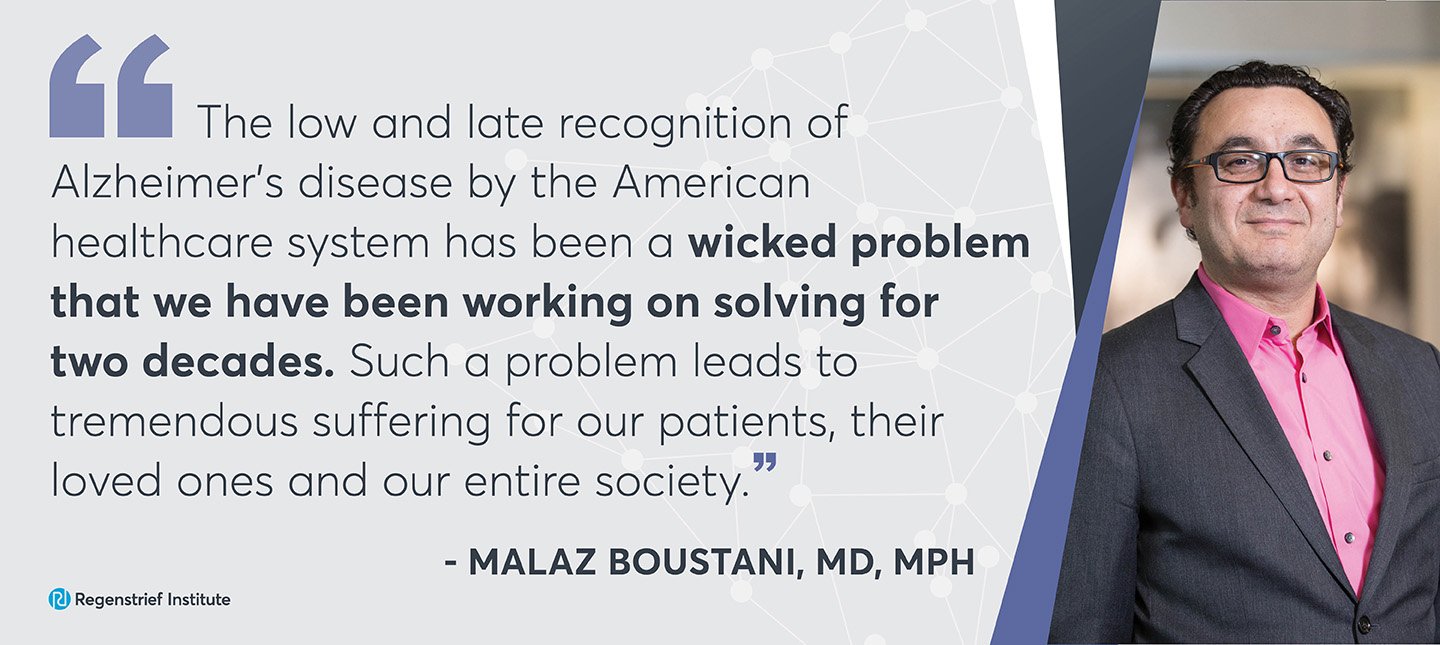Three studies will evaluate the effectiveness of using passive digital markers
Researchers from Indiana University School of Medicine, Regenstrief Institute, IUPUI and University of Miami Miller School of Medicine will study a problem that has been vexing healthcare professionals and families for decades, using scalable, low-cost, and noninvasive approaches to identify Alzheimer’s disease and help improve the quality of life for patients and families. The grant from the National Institutes of Health’s National Institute on Aging is expected to total nearly $5 million over five years.
About half of people who have Alzheimer’s disease never receive a diagnosis, and for those who do, it can take three to five years after the onset of symptoms before the disease is identified.
The three studies will be led by Malaz Boustani, M.D., MPH of Regenstrief Institute and IU School of Medicine; Zina Ben Miled, PhD, M.S. of the Purdue School of Engineering and Technology at IUPUI and James Galvin, M.D., MPH of Miami’s Miller School of Medicine. Studies will be conducted in both Indiana and Florida.
“The low and late recognition of Alzheimer’s disease by the American healthcare system has been a wicked problem that we have been working on solving for two decades. Such a problem leads to tremendous suffering for our patients, their loved ones and our entire society,” said Dr. Boustani, a Regenstrief Institute research scientist and a professor of medicine at IU School of Medicine. “Early detection can help patients and their families develop a brain care plan and potentially lessen the burden of the disease. Our goal with this study is to provide validated tools for early detection that are easy for the patient and the provider, that are scalable, and that are sustainable.”
Researchers plan to conduct a rigorous and reproducible evaluati on in the real world of two scalable tools:
- a passive digital marker developed by Drs. Ben-Miled and Boustani, and
- a patient reported outcome tool developed by Dr. Galvin.
“Passive digital markers are developed by using data from electronic health records,” said Dr. Ben Miled, an IUPUI associate professor and engineer. “The benefit of this approach is that the information has already been collected and requires no extra effort from the patient or the provider. Through artificial intelligence techniques such as machine learning algorithms and natural language processing, we can use this data to identify people who may be at risk for Alzheimer’s disease without the need for invasive and costly tests.”
Past research has shown these passive digital markers to be as effective as the current, more invasive and expensive tests for Alzheimer’s disease.
One study, two trials
The Digital Dementia Detection (D3) project contains three complementary studies.
The first study will be a clinical validation study taking place in both Indiana and Florida. The second study will be an agile, adaptive, pragmatic trial conducted at Indiana to evaluate the impact of implementing the tools in the real world of primary care. The third study will be a replicative pragmatic trial in primary care clinics in South Florida.
Researchers will be comparing the use of passive digital markers, the use of digital markers plus a patient-reported outcome measure developed by the University of Miami, and usual care to determine if any of the early detection strategies leads to an increase in early Alzheimer’s detection.
“Through this project, we hope to prove that these approaches can be successfully implemented in the real world, leading to benefits for both patients and their families,” said Dr. Galvin, a professor at the Miller School of Medicine and a cognitive neurologist. “Combining a patient-reported outcome with a passive digital marker is an innovative and highly sensitive way to detect mild cognitive impairment, Alzheimer’s disease and related disorders, yet low burden to patients and clinicians for ease of use”
“Passive digital markers hold a lot of promise for the future of healthcare,” said Dr. Boustani. “They could be used to identify at-risk populations for other conditions, leading to both better care and cost savings. We look forward to seeing the efficacy of this approach in the clinic.”
Other researchers involved in this study are Nicole Fowler, PhD, MHSA; Paul Dexter, M.D.; Randall Grout, M.D., M.S. and Patrick Monahan, PhD, all from IU School of Medicine and Regenstrief Institute, and Michael Kleiman, PhD from the Miller School of Medicine.
This research is supported by the National Institutes of Health’s National Institute on Aging, grant 1R01AG069765-01.
About Regenstrief Institute
Founded in 1969 in Indianapolis, the Regenstrief Institute is a local, national and global leader dedicated to a world where better information empowers people to end disease and realize true health. A key research partner to Indiana University, Regenstrief and its research scientists are responsible for a growing number of major healthcare innovations and studies. Examples range from the development of global health information technology standards that enable the use and interoperability of electronic health records to improving patient-physician communications, to creating models of care that inform practice and improve the lives of patients around the globe.
Sam Regenstrief, a nationally successful entrepreneur from Connersville, Indiana, founded the institute with the goal of making healthcare more efficient and accessible for everyone. His vision continues to guide the institute’s research mission.
About IU School of Medicine
IU School of Medicine is the largest medical school in the U.S. and is annually ranked among the top medical schools in the nation by U.S. News & World Report. The school offers high-quality medical education, access to leading medical research and rich campus life in nine Indiana cities, including rural and urban locations consistently recognized for livability.
About IUPUI
As Indiana’s premier urban public research university, IUPUI believes in the power of transformation. It is committed to providing educational opportunities that transform the lives of students, the community, and the changing world. It offers more than 450 undergraduate, graduate and professional programs from Indiana University and Purdue University.
About University of Miami Miller School of Medicine
The University of Miami Miller School of Medicine is an innovative institution that empowers students and trainees to transform lives and inspires them to serve the global community. Founded in 1952, it was Florida’s first medical school. It now includes 21 clinical departments, 6 basic science departments, 45 centers and institutes, and more than 1,400 faculty members. South Florida’s cultural diversity makes it a medical training ground of unmatched opportunity.
About Malaz Boustani, M.D., MPH
In addition to his role as a research scientist at Regenstrief Institute, Malaz Boustani, M.D., MPH, is the founding director of the Center for Health Innovation and Implementation Science. He is a professor and the Richard M. Fairbanks Chair in Aging Research at Indiana University School of Medicine.
About Zina Ben Miled, PhD, M.S.
Zina Ben Miled, PhD, M.S., is an associate professor of electrical and computer engineering in the Purdue School of Engineering and Technology at IUPUI and a research scientist in the Center for Health Innovation and Implementation Science. She is also a Regenstrief Institute affiliate scientist.
About James Galvin, M.D., MPH
James Galvin, M.D., MPH is a professor of neurology at the University of Miami Miller School of Medicine. He is the founding director of the Comprehensive Center for Brain Health and chief of cognitive neurology for Palm Beach and Broward County in the Department of Neurology.










